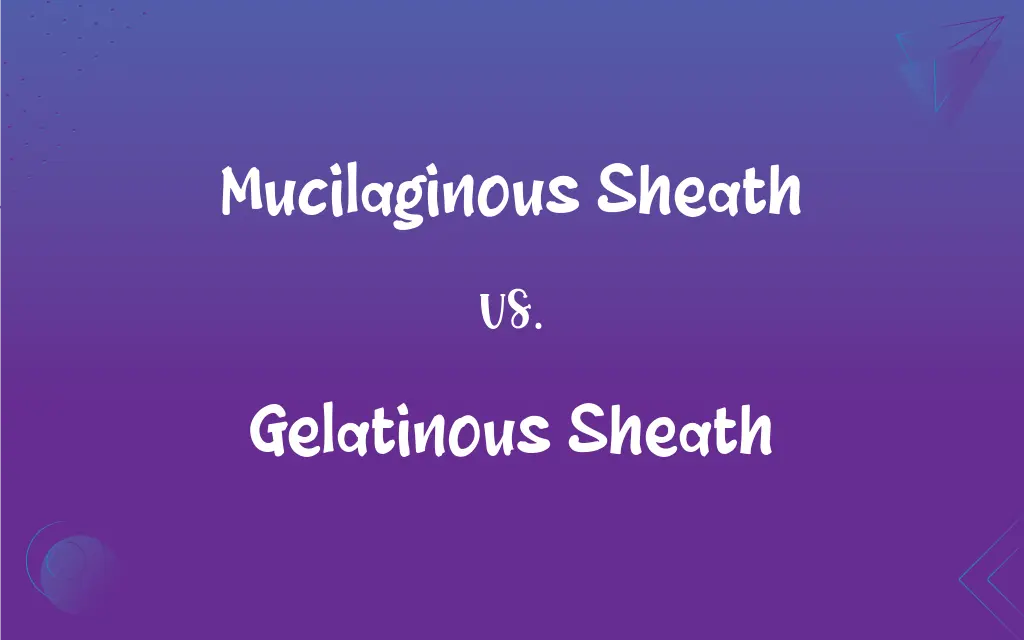Mucilaginous Sheath vs. Gelatinous Sheath: What's the Difference?
Edited by Aimie Carlson || By Janet White || Published on January 18, 2024
A mucilaginous sheath is a slimy layer protecting some bacteria and algae, aiding in moisture retention and adhesion, while a gelatinous sheath is a thicker, jelly-like coating offering similar protection and support.

Key Differences
Mucilaginous sheath, commonly found in some algae and bacteria, is characterized by a sticky, viscous texture. Gelatinous sheath, on the other hand, is more prevalent in certain microbes, featuring a softer, more jelly-like consistency. Each sheath plays a role in protecting and supporting the organism.
The mucilaginous sheath is primarily composed of polysaccharides, contributing to its gluey nature. The gelatinous sheath, while also polysaccharide-rich, has a different composition that results in a gel-like texture. Both sheaths assist in adherence to surfaces and protection from environmental stress.
Organisms with a mucilaginous sheath often use it to attach to solid surfaces or other organisms. In contrast, the gelatinous sheath can act as a barrier against predators and harmful substances, due to its softer, more absorbent nature.
The mucilaginous sheath is generally tougher and more resistant to physical disturbances. The gelatinous sheath, with its jelly-like quality, offers less resistance and is more prone to deformation.
Both sheaths play crucial roles in the survival and ecological interactions of the organisms they envelop. The mucilaginous sheath often aids in nutrient absorption, while the gelatinous sheath can play a role in buoyancy and movement in aquatic environments.
ADVERTISEMENT
Comparison Chart
Texture
Sticky and adhesive
Soft and jelly-like
Composition
High in polysaccharides, viscous
Polysaccharide-rich, gel-like
Function
Adherence, protection, nutrient absorption
Protection, buoyancy, movement support
Environmental Interaction
Attaches to surfaces, other organisms
Acts as barrier, absorbent
Physical Properties
Tougher, resistant to disturbances
Softer, prone to deformation
ADVERTISEMENT
Mucilaginous Sheath and Gelatinous Sheath Definitions
Mucilaginous Sheath
Sticky Covering.
The mucilaginous sheath enables the bacterium to adhere to rocks.
Gelatinous Sheath
Protective Layer.
The algae's gelatinous sheath protects it from predators.
Mucilaginous Sheath
Protective Layer.
The algae's mucilaginous sheath shields it from harsh sunlight.
Gelatinous Sheath
Buoyancy Aid.
The aquatic plant's gelatinous sheath aids in keeping it afloat.
Mucilaginous Sheath
Adhesive Coating.
The plant's mucilaginous sheath helps it stick to other plants.
Gelatinous Sheath
Gelatinous Barrier.
The microbe's gelatinous sheath filters out harmful substances.
Mucilaginous Sheath
Viscous Envelope.
The mucilaginous sheath provides a barrier against drying out.
Gelatinous Sheath
Jelly-Like Cover.
The organism's gelatinous sheath allows it to float in water.
Mucilaginous Sheath
Nutrient Absorber.
Through its mucilaginous sheath, the microbe efficiently absorbs nutrients.
Gelatinous Sheath
Soft Coating.
The gelatinous sheath of the bacterium acts as a cushion against impact.
FAQs
Is the mucilaginous sheath important for nutrient absorption?
Yes, it plays a significant role in nutrient absorption.
What is a mucilaginous sheath?
A sticky, viscous covering found on certain organisms.
Can the gelatinous sheath act as a barrier?
Yes, it can protect against predators and harmful substances.
What organisms typically have a mucilaginous sheath?
Some algae and bacteria.
What is the primary function of a mucilaginous sheath?
To protect, adhere to surfaces, and absorb nutrients.
How does a mucilaginous sheath differ from a gelatinous sheath?
It's stickier and more adhesive compared to the softer, jelly-like gelatinous sheath.
Do both sheaths have similar compositions?
They are both polysaccharide-rich but differ in texture and properties.
Is the gelatinous sheath more prone to deformation?
Yes, due to its softer, gel-like nature.
What are the key functions of a gelatinous sheath?
Protection, aiding buoyancy, and supporting movement.
What is a gelatinous sheath?
A soft, jelly-like coating found on certain microbes.
Are these sheaths visible to the naked eye?
They can be, depending on the organism and the thickness of the sheath.
Do both sheaths contribute to the survival of the organism?
Yes, they play crucial roles in survival and ecological interactions.
Can the gelatinous sheath aid in filtering out substances?
Yes, it can act as a filter against harmful substances.
Is the gelatinous sheath important for aquatic organisms?
Yes, especially for buoyancy and movement.
Can the mucilaginous sheath help in adhesion?
Yes, its sticky nature aids in adherence to surfaces.
Is the mucilaginous sheath resistant to physical disturbances?
Generally, it is tougher and more resistant.
Are these sheaths unique to certain types of environments?
They are more common in aquatic and moist environments.
Does the mucilaginous sheath aid in protection against environmental stress?
Yes, it offers protection against various environmental factors.
Can the gelatinous sheath support movement in water?
Yes, it aids in movement and buoyancy in aquatic environments.
Do both sheaths aid in the organism's interaction with its environment?
Yes, they play significant roles in environmental interaction and adaptation.
About Author
Written by
Janet WhiteJanet White has been an esteemed writer and blogger for Difference Wiki. Holding a Master's degree in Science and Medical Journalism from the prestigious Boston University, she has consistently demonstrated her expertise and passion for her field. When she's not immersed in her work, Janet relishes her time exercising, delving into a good book, and cherishing moments with friends and family.
Edited by
Aimie CarlsonAimie Carlson, holding a master's degree in English literature, is a fervent English language enthusiast. She lends her writing talents to Difference Wiki, a prominent website that specializes in comparisons, offering readers insightful analyses that both captivate and inform.































































